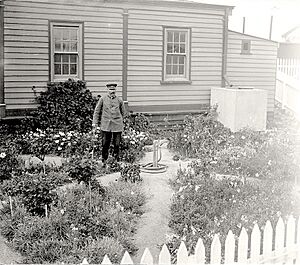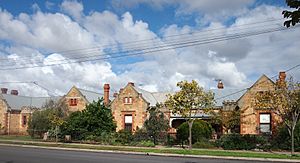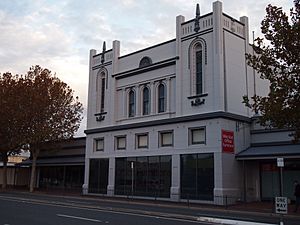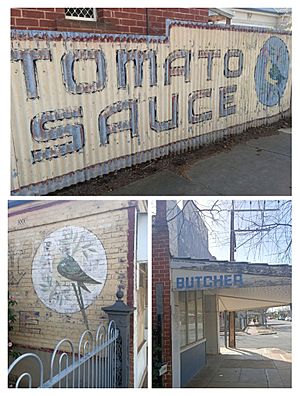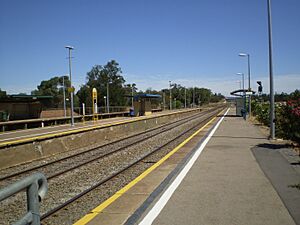Mile End, South Australia facts for kids
Quick facts for kids Mile EndAdelaide, South Australia |
|||||||||||||||
|---|---|---|---|---|---|---|---|---|---|---|---|---|---|---|---|
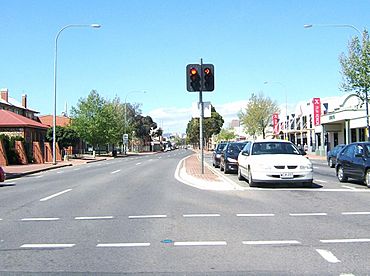
Henley Beach Road, looking east into the city
|
|||||||||||||||
| Established | 1860 | ||||||||||||||
| Postcode(s) | 5031 | ||||||||||||||
| Area | 1.81 km2 (0.7 sq mi) | ||||||||||||||
| Location | 2 km (1 mi) W of Adelaide | ||||||||||||||
| LGA(s) | City of West Torrens | ||||||||||||||
| State electorate(s) | West Torrens | ||||||||||||||
| Federal Division(s) | Adelaide | ||||||||||||||
|
|||||||||||||||
Mile End is a suburb located just west of Adelaide in South Australia. It's about 2 kilometers (a little over a mile) from the very center of Adelaide. In 2011, about 4,413 people lived there. Most of Mile End is made up of homes, but you'll also find shops and businesses along busy roads like Henley Beach Road and South Road.
Contents
Mile End's History
Mile End was first created in 1860 by the South Australian Company and was called The Town of Mile End. It got its name because it was about one mile from the heart of Adelaide. It was also named after a place called Mile End in East London, England, which has a similar meaning.
At first, Mile End was part of a larger, mostly farming area called the District of West Torrens. But in 1883, people living in Mile End and nearby suburbs like Thebarton and Torrensville wanted to have their own local government. So, they formed the Corporation of the Town of Thebarton. Later, in 1997, the Town of Thebarton joined back with the City of West Torrens.
Long ago, from 1859 to 1869, a group of "sporting gentlemen" used a large area of grazing land in Mile End for horse races. This place was known as the "Thebarton Racecourse." You can still see its history in the street names today, like Falcon Street, Ebor Street, and Cowra Street. These streets are named after famous racehorses from that time!
The Mile End railway station, built in 1898, is also about one mile from the main Adelaide railway station.
Homes in Mile End
Many years ago, good housing for working-class people was hard to find. A rich man named Thomas Elder wanted to help. When he passed away in 1897, he left £25,000 to build homes and other useful places like libraries and schools for working men and women.
This money led to the creation of Adelaide Workmen's Homes Inc. They hired architects Edward Davies and Charles Walter Rutt to design special low-cost rental homes in Rose Street, Mile End. These homes were built in 1901–2. They are red brick cottages with stone fronts and unique castle-like tops above the entrances. These buildings are so important that they are listed among the 120 most significant 20th-century buildings in South Australia!
Railway Yards in Mile End
The Mile End Goods Yard and engine sheds opened in 1912. This was a big railway complex where freight trains could load and unload goods. A special railway track called the Gaol Loop was built so freight trains could go directly to Mile End without passing through the busy Adelaide railway station. This helped the Adelaide station focus on passenger trains.
The Mile End Goods Yard was a very important railway hub until the 1980s. Some of the original homes built for railway workers are still in Mile End today. However, over time, fewer goods were transported by train in Australia. Because of this, the Mile End Goods Yard became less important. The Mile End Goods railway station, which was a stop for local trains, was closed and taken down in 1994.
There was also a Mile End Railway Museum here until 1988. It then moved to Port Adelaide and became the National Railway Museum.
Mile End's Heritage Sites
Mile End has several places that are listed as heritage sites, meaning they are important historical locations:
- Bagot Avenue: Council Boundary Marker, Mile End
- 1A Falcon Avenue: St James' Anglican Church School
- 2-4 Henley Beach Road: Thomas Hardy & Sons Wine Cellars
- 94 Henley Beach Road: Savings Bank of South Australia Building
- 36-50A & 39-45A Rose Street: Adelaide Workmen's Homes
- 32-56 Sir Donald Bradman Drive: Adelaide Electric Supply Co Ltd Complex
Mile End's People
In 2006, a survey showed that 3,918 people lived in Mile End. About half of them were female, and most (62.5%) were born in Australia. A smaller group (6.3%) were born in Greece. Most residents (over 81.3%) were Australian citizens.
Mile End has many educated people, with over 40.8% having a degree or other qualification. This shows in the types of jobs people have. The most common jobs were in Health Care (11.9%), Retail (11.6%), and Education (9.6%). The average household income was about A$918 per week. When it came to religion, 21.9% of people said they were Catholic, while a slightly higher number (24.5%) said they had no religion.
Getting Around Mile End
Most people in Mile End use cars to get around. About 61.8% of residents drive or ride in a car to work. Mile End is well-connected to major roads like South Road, Sir Donald Bradman Drive, and Henley Beach Road. You can usually reach Adelaide's city center by car in about 5 minutes.
Because Mile End is close to business areas, many people choose to walk (5.6%) or bike (2.7%) to work. Public transport is also a good option, with 13.5% of people taking the bus. A small number (0.5%) use the train. Buses connect Mile End to the city, Adelaide Airport, Glenelg, and other western suburbs.
The Mile End railway station is on the Seaford, Tonsley, and Belair train lines. However, trains outside of busy times (peak hour) only run once an hour. There are no train services on weekends, public holidays, or at night.
Important Organisations in Mile End
Mile End is home to the main office of the Australian Rail Track Corporation. This company manages most of Australia's railway tracks.
You can also find the Shark Museum of Australian filmmaker and conservationist Rodney Fox in Mile End. Rodney Fox is famous for surviving a great white shark attack and is one of the world's top experts on sharks. His museum is on Henley Beach Road, across from the Thebarton Theatre.
Famous People from Mile End
- Claude Alfred Haigh (1904-1980): A person who made sweets and bred racehorses.
- Barbara Hanrahan (1939–1991): A talented artist, printmaker, and writer.
- Kenneth Thomas Hardy (1900-1970): A person involved in the wine business.
- Allan McLean (1914-1989): Also known as Bob McLean, he was a cricketer, an Australian Rules footballer, and a sports manager.


